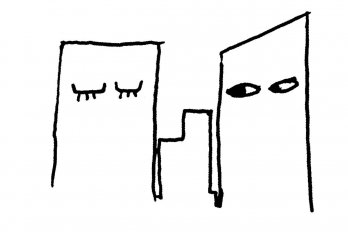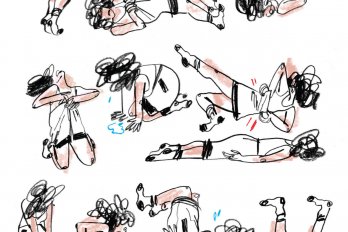Before she was famous, Blue was dead. In the spring of 2014, in the Gulf of Saint Lawrence, a shift in the winds trapped a pod of blue whales under the ice, and she was one of nine to perish. In late April, her twenty-four-metre-long corpse washed up on the shore of Trout River, Newfoundland. When another member of her pod turned up at the nearby village of Rocky Harbour, internet rumours spread fear that the whales could spontaneously explode. The media erupted: “What Do We Do with This Whale?” (The New Yorker), “Could Whales Explode in Canadian Towns?” (CNN), and “Beached Dead Whale Stinks Up Town in Newfoundland,” (Associated Press). Saturday Night Live aired a hammy sketch about a beachside romance gone wrong: it begins with a ukulele ballad and ends in a mess of guts and blubber.
Mark Engstrom, a senior curator and deputy director at Toronto’s Royal Ontario Museum, had been working for fourteen years to build a collection of whales that inhabit Canadian waters. He already had the skeletons of a sperm whale and a humpback, but a blue whale—the world’s largest animal—would be the ultimate acquisition. On May 8, he and a group of technicians arrived in Newfoundland to harvest Blue’s bones with a set of specially made flensing knives. Engstrom’s work at the ROM often requires him to wear a blazer, but he’s happiest when knee-deep in guts. “I’m a mammologist,” he says. “For me, this is the best part of the job.”
The ROM team, dressed in chest waders, rain jackets, and heavy-duty rubber gloves, began cutting into Blue’s body, peeling back the skin, and removing layers of blubber, muscle, and innards. The team sent six truckloads of rotting flesh—which one curator referred to as “mushy, almost cheesy”—to a nearby dump, and packed the bones in shipping containers bound for Ontario.
This March, the ROM will open Out of the Depths: The Blue Whale Story, featuring Blue’s preserved skeleton, which will later be joined by the world’s first plastinated blue whale heart. A successful museum exhibition needs both a compelling specimen and a strong story, and in Blue, Engstrom had both. Harvesting the hulking, distended body was one thing; telling its story is another. To do that, the curators confronted tricky questions—about delivering a message of conservation without being crassly political, and about the role of natural-history museums in our ecologically troubled moment.
Last September, at a warehouse in Trenton, Ontario, technicians dug up Blue’s bones (they had been buried in compost for a year so that bacteria would eat the remaining flesh) and subjected the specimens to detergent baths. Whale bones are difficult to clean: they’re as porous as sea sponges and as oily as hush puppies.
Nearby, a half-complete T. Rex skeleton looks pathetic relative to Blue’s. The whale’s vertebrae resemble the propellers of a cruise ship; her mandibles are like daggers that could slay Godzilla; and her skull, which requires a forklift and crane to move, is comparable in size and weight to a pickup truck. And the odour, even though the whale has been relieved of its flesh, is a dark animal musk—the smell of death writ large.
For more than a century, the curious were willing to brave that smell for the chance to get close to a cetacean. Whales were mythical creatures that also happened to exist. In 1903, in preparation for the St. Louis World’s Fair, workers from the Smithsonian travelled to Hermitage Bay, Newfoundland, to cast the body of a twenty-four-metre blue whale in plaster as it decomposed. In postwar Europe, thrill-seekers flocked to see Hercules, Goliath, and Jonah, three Norwegian fin whales casually preserved in formaldehyde and trucked from town to town. The tour ended when the bodies became too putrid to display.
Our eagerness to marvel at whales was rivalled only by our desire to kill them. In the nineteenth century, oil extracted from blubber lit lamps and greased hydraulic pumps, and their baleen plates lined corsets. By the early twentieth century, petroleum and polymers were making whale products obsolete. And yet, thanks to the exploding harpoon and the advent of faster ships, we’d finally figured out how to slaughter blue whales en masse—so we kept doing it.
The practice was catastrophic for the species. The global population of blue whales once numbered in the hundreds of thousands, but by 1966, when the International Whaling Commission introduced a hunting ban, it had been pushed to near extinction. “Next to the bison, there was never a bigger slaughter of a single species,” says Dave Ireland, managing director of biodiversity at the ROM. In the northwest Atlantic, for a reason not yet identified, the blue whale population has fallen to roughly 200, and it isn’t growing. According to that estimate, the 2014 freeze in the Gulf of Saint Lawrence wiped out nearly 5 percent of an already imperilled population.
That devastating event is where the ROM’s curatorial narrative begins. From the outset, the curators understood that, however they told their story, Blue must be the main character. While planning exhibitions, the museum tests its themes in focus-group meetings. The first consultation sent a clear message. “People felt very strongly that this exhibition shouldn’t be about a blue whale but rather this blue whale,” says Courtney Murfin, the museum’s interpretive planner. “We needed to emphasize that this is the same whale you fell in love with three years ago.”
Patrons will enter the exhibition through an antechamber, in which informational panels and news footage will reconstruct the 2014 die-off and the media circus that followed. Then, in the main space, they’ll meet Blue. The decision to focus on Blue led to two tricky questions. First, should the exhibition delve into the gritty details of the bone harvest? In the past, the institution’s family-friendly mandate discouraged graphic displays, but evidence shows that icky subject matter goes over well with patrons. A time-lapse video of a decomposing fox is among the most-watched audiovisual pieces in the museum.
And so the team doubled down on all things visceral: patrons won’t just see the bone harvest, they’ll also smell it, perhaps by getting close to an article of clothing or a watch that the technicians wore while cutting up Blue’s body. They’ll stand alongside an illustration of a blue whale penis, and examine a jar of blue whale feces—presented with an explanation of its importance to ocean ecology.
The second curatorial question was more fraught: How do you tell the story of Blue’s death when the underlying cause is hazy? We know that blue whales—along with rights, minkes, and humpbacks—enter the Gulf of Saint Lawrence to feed. The 2013/2014 winter was so cold that most of the Great Lakes and Saint Lawrence Seaway froze over. After the whales entered the gulf, ice was blown east toward the Newfoundland coast, crushing or drowning them before they could escape.
The connections with climate change and environmental degradation are tenable, if not entirely clear. It’s possible that ocean acidification—a process that’s bound up with global warming—is undermining blue whales’ food supply, and in turn undermining the health of the northwest Atlantic pod. Then there’s the matter of population growth. Blue whale mating habits are obscure—the animals flirt over several hundred kilometres and mate somewhere far out to sea—so we don’t know why northwest Atlantic whales aren’t calving. Perhaps noise from ships is interfering with long-range mating signals. Ireland acknowledges that the 2014 die-off might have resulted from a freak weather event and nothing more. Then again, freak weather events are alarmingly common these days.
Engstrom, however, argues that there isn’t enough evidence to make the climate change argument work. “I had to tell my team that this particular exhibition isn’t about global warming,” he says. He worries that climate change is becoming an easy narrative that curators exploit when their work needs gravitas.
Historically, natural-history museums have been unconcerned with environmental advocacy. These are Victorian institutions—places of edification, discovery, and wonderment—whose predecessors are the curio cabinets of Renaissance Europe. Over the last few decades, however, with cataclysm looming large, it became harder to discuss the natural world without also advocating for it. And so museums, the ROM included, made environmentalism part of the mission.
Engstrom is hardly opposed to such thinking. He’s currently working on a massive exhibition about how climate change is devastating the Arctic. “If we want to tell a climate change story,” he says, “we need to really tell it, instead of dragging it in where it doesn’t belong.”
Since whales are iconic and elusive, we often treat them more as symbols—in the medieval period, they stood for monstrousness, and in the Romantic era, solitude—than as organisms in their own right. They are fascinating because they’re superlative. They have brains five times the size of ours but a consciousness that is wholly unknowable. Their calls make them seem at once otherworldly and familiar: like humans, they sing to each other; unlike us, they do so in ethereal, alien tones.
Out of the Depths avoids this kind of sentimentalism. It doesn’t treat the 2014 die-off as an allegory for our endangered planet. It focuses instead on the species itself and its extraordinary natural history. Visitors will get to measure their flimsy mass and rapid heart rate against those of a heavy, slow-pulsing blue whale. They’ll pass through a sound chamber projecting a blue whale call, a low-frequency rumble that can be heard thousands of kilometres away. And they’ll see cast fossils of “transitional whales”—uncanny long-snouted creatures with semi-articulated limbs—that mark the cetacean’s origins as a hoofed land mammal similar to a pig or deer.
Ireland says he “fought hard” to have climate change at least mentioned in the show, if only as one topic among many. He’s satisfied with the compromise. “We’ve learned through audience research that the doom-and-gloom messages aren’t working,” he says. “If you’re preaching from the pulpit and telling people what you think they need to hear, the chances of them turning off is really high.” He recalls a diorama at the American Museum of Natural History that showed an emaciated polar bear crawling over a garbage dump. “Why not also give a beautiful image of a polar bear?” he asks. “Then, at the end, you can say, ‘If you want to help, here are some things you can do.’”
If the blue whale exhibition awes you, then you’ll be more receptive to a hint, subtly delivered, about where to go from here. There’ll be an interactive map showing the importance of marine-protected areas that safeguard whales from ship strike, a video featuring environmental organizations you might support, and a short animation explaining that when a blue whale dies, it sinks slowly to the ocean floor, sequestering carbon and providing nutrients to a deep-water system. Blue whales, says Ireland, are “phenomenal ecosystem engineers.”
For curators looking to foster ecological awareness, the old Victorian ideal—of stimulating curiosity and wonderment—may still be the best place to start. To marvel at a species is to begin to care about it. And to encounter a blue whale, in the wild or in a museum, is to confront the radical otherness of the non-human world. It’s often said that to be an environmentalist, you have to stop thinking of people as the highest life form. Many of us have reckoned with this idea intellectually, but get close enough to a blue whale, and you’ll feel it instinctively, too.
This article appeared in the April 2017 issue under the headline “The Politics of Rotting Blubber.”




